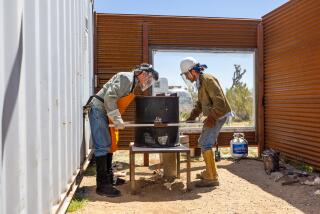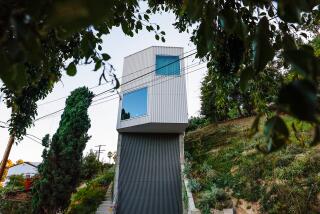Going Underground Down Under to Create Homes, Lodgings
WHITE CLIFFS, Australia — He never planned on going underground, never figured on investing two decades tunneling through a desert ridge to build his own cool, insulated honeycomb, room by grueling room. Leon Hornby was just passing through, that was all.
But something, he’s not sure just what, sucked him in. He saw the families who lived--often reasonably well--in old opal-mining caves. He bought some property. He dug. He crafted. He polished and smoothed and invited guests to come by. And when he’d dug all he could--well, then Leon Hornby dug some more.
Now, 23 years later, he runs the Underground Dug-Out Motel, the latest incarnation of a 105-year cave-dwelling tradition started by opal diggers who sought fortune-- and refuge from the blistering sun --in the sandstone hills of Australia’s eastern Outback plains.
Think of it: Thirty rooms with electricity, carpeting and the comforts of home. All 25 feet underground. All inside a big hill. All dug out by hand and jackhammer from a tough substance that’s somewhere between very hard clay and semihard rock.
“This,” says Hornby, sedate but obviously proud, “is a once-upon-a-time kind of place.”
Distances Gauged in Hours, Not Kilometers
It’s also a connection to a strange regional history--one of those things that visitors file in their “Only in Australia” folders.
White Cliffs, 500 miles northwest of Sydney and home to 200 people on a crowded day, is remote by most any standard. You can’t get here without driving miles of dirt road. There’s no suburb, no police station, not even a mall. The nearest supermarket, in Broken Hill, is a 350-mile round trip. And because of the rugged terrain, people speak of distances not in miles or kilometers but in hours.
The cliffs are about all that’s remotely white around here. The people, mostly of European stock, aren’t; years of sun have baked them golden brown. The mineral-rich soil glows red under a deep blue sky.
Miners and speculators first found opal in the mid-1880s, and a decade later some diggers moved into the mines to escape the brutal heat. By 1900, White Cliffs had an underground bar, restaurant and bakery.
Why would they choose caves? In the early days, building materials like timber and iron were scarce, costly and shipped in over great distances--just as they are today. The caves, carved from structurally sound sandstone and not needing timber supports, were an ideal if unorthodox alternative. (There have been no recorded fatalities from dugouts collapsing, though some flood occasionally.)
White Cliffs has about 140 dugouts, each unique. Some folks stay seasonally; others live here all year --ardent nonconformists like Jock Goldsmith, a boisterous dugout-dweller who has amassed an odd collection of beer bottles, dusty old machines and myriad other knickknacks in the tunnels behind his home.
Goldsmith, a former opal digger and sheep shearer who embraces the “Mad Jock” moniker that townsfolk have given him, arrived 35 years ago and found old miners’ tunnels still intact. “All I had to do was take the loose dirt out,” he says, pacing through the darker parts of his home.
Unlike the motel, Goldsmith’s house feels like a cave. He has not painted over the rock, which juts out jaggedly in places. It’s dusty, and the bulbs are bare.
“A lot of people don’t like being underground. They think it’s not healthy,” Goldsmith says. And after this long, he’s ready to get out himself. He’s asking $43,000-- $38,000 without the knickknacks-- but he’s not optimistic.
“Who’s gonna buy it?” he barks. “I’m sick to death of the place. Anyone tells you they love living in White Cliffs, don’t believe ‘em. You live here because of poverty.”
Of course, it’s not as if there are a lot of employers--or a lot of anything at all, except vast expanse. But people have grown so accustomed to dugout living that anything else would seem strange.
“Houses feel a bit ordinary when we go away,” says Peter Pedler, who lives with his wife, Joanne, and their toddler in a dugout on Turley’s Hill. They spent years turning it into a bed-and-breakfast called PJ’s Underground--a genteel hostel of good cooking and fine furnishings that, if you open the back door of the back bedroom, happens to lead smack into an opal mine.
“I don’t know why more places in Australia don’t do this,” Joanne Pedler says.
One has: Coober Pedy, another opal town 450 miles west of here, features dugout homes and even an underground church.
For Hornby, 70, the saga began in 1977 when he passed through with his son, Peter, while digging dams for sheep farmers on area “sheep stations.” Temperatures varied wildly, but the naturally insulated dugouts stayed between 70 and 75 degrees.
“I was fascinated,” Hornby recalls. Within a month, he had bought property on Smith’s Hill, one of three that overlook the town and the only one not dug into by miners. It contained no valuable opal; 100 million years ago, it was an underground sea.
Hornby and his son began digging; they fashioned five bedrooms in 11 years, enough for two spacious homes by 1987. When the hotel in town was full, they were asked to help with the overflow, and that gave them an idea.
They began to dig again--full time for 2 1/2 years--trucking in supplies on wide-load trailers across the dirt roads. They had no blueprint; they changed their minds 10 times while they were digging. In May 1989 they opened their 24-room motel. Since then they have added six rooms. It’s intricate, to be sure; guests get a map.
Hornby is adding two more rooms, cutting through the hill with the same hand-held jackhammer. And his reputation is spreading; he and his son have been hired to dig two private homes nearby.
“It’s a way of life that grows on you,” Hornby says. “You come and live underground and don’t know what’s going on in the outside world.”
CEOs from Sydney have been known to fly in for some solitude-- among them a candy executive, a mining company president and the headmaster of a prestigious boys’ school. They land in private planes on a dirt airstrip and let the world seep out of them for a few days. Then there are the builders, plumbers and architects who stop in because they’re fascinated with the logistics.
“People are really interested in alternate ways of life,” says Andrew Morse, Hornby’s son-in-law. “They live in the city, in suburbia. When they come out here and see people who have turned their backs on that way of life, that intrigues them.”
From Simple Cave to Self-Sustaining Warren
But living here for a lifetime? Well, why not? Robyn Taylor, who grew up on a sheep station 20 miles from White Cliffs and used to attend dances there, is amazed at how the dugouts have evolved from one-room caves to self-sustaining warrens.
“They’re their own people. They do their own thing,” Taylor says. “But if you live in that area, you know what the weather can be like and you understand it.”
Hornby has established a legacy inside his hill. Though he’s trying to sell the place and retire, there’s little chance his work will disappear; after all, it’s one of only a half-dozen accommodations for 150 miles--and the only one where a busload of tourists can live for a night in a well-heeled cave.
“We’ll bring the children back one day,” says his daughter, Ann Morse. “We’ll come here and say, ‘Look what grandpa built.’ ”
More to Read
Sign up for The Wild
We’ll help you find the best places to hike, bike and run, as well as the perfect silent spots for meditation and yoga.
You may occasionally receive promotional content from the Los Angeles Times.






